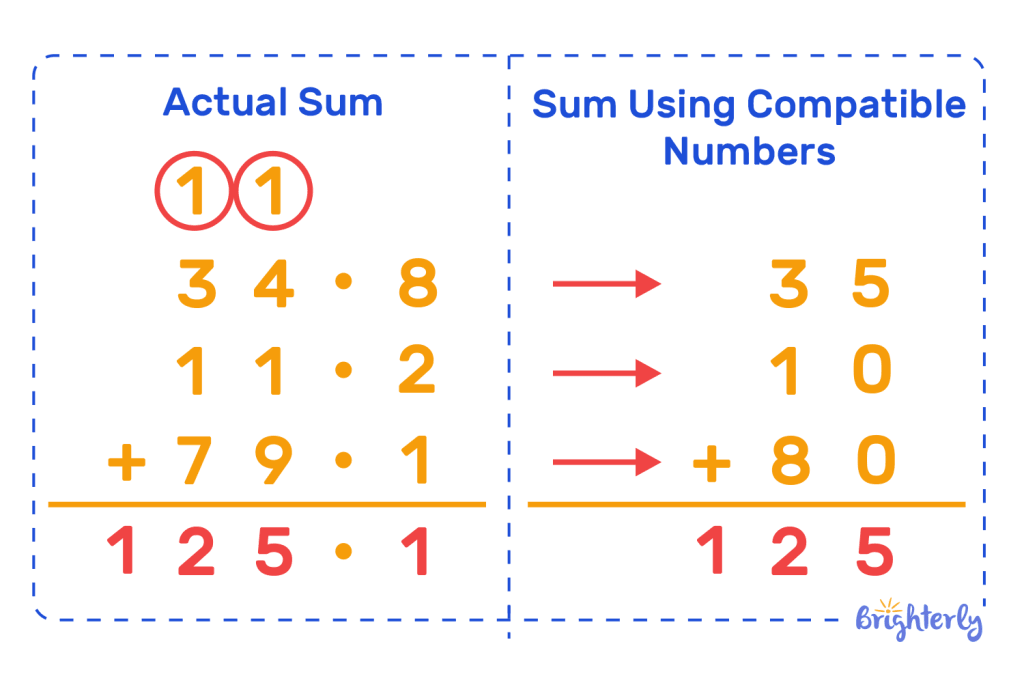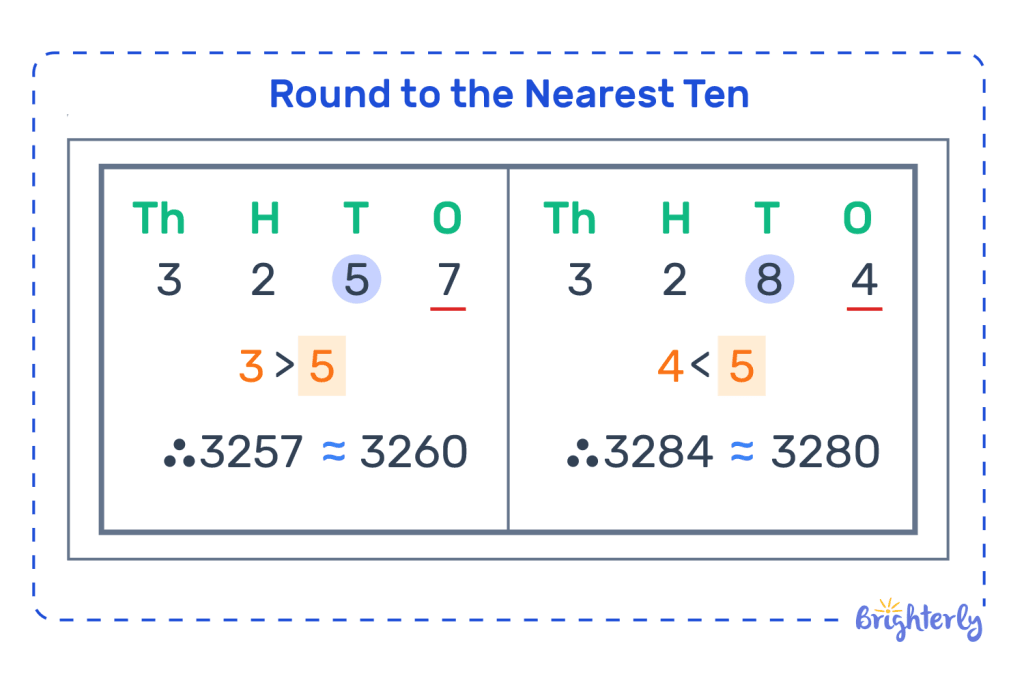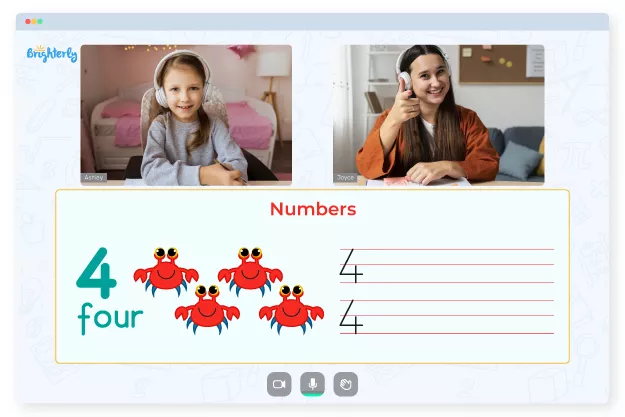Compatible Numbers
Updated on November 3, 2025
Here at Brighterly, we want to make learning math as fun and accessible for all students as possible. That’s why we cover all key mathematical concepts on our site, as well as handy concepts that can actually make math easier.
Today we’re going to be covering the concept of compatible numbers. These numbers can make mental calculations feel so much less daunting and can give you more confidence when tackling challenging math problems.
Here, we’re going to cover the concepts of number sense and compatible numbers, the compatible numbers math definition, how compatible numbers work in addition and subtraction and how they compare to rounding. We’ve also included some solved math questions so you can understand how to answer questions using compatible numbers, then some practice questions you can try out for yourself!
Let’s get into it!
What is number sense?
Number sense is the most foundational skill in math. When you have number sense, you have an innate understanding of how numbers work, their relationships with one another and how some numbers are larger or smaller than others.
When you have strong number sense, you’ll also understand the basics of operations like addition, subtraction, multiplication and division. You’ll be able to do mental math and solve simple sums and equations in their heads. Strong number sense is a key skill for learning how to use compatible numbers.
What are compatible numbers?
Compatible numbers are numbers that are easy to work with in calculations and equations. This means they usually end in 0 or 5, and sometimes even numbers can also be considered compatible.
You might also refer to some of these values as round numbers. A round number is one that ends in 0, but often people use the term compatible numbers to describe them.
Compatible numbers are useful not only for solving math problems but also for making estimates – a skill valuable in both math and everyday life. You can even use a compatible number calculator to find the best ones to work with.

Compatible numbers in addition
Compatible numbers are especially useful in addition. If you have two complex numbers to add together, they can make the calculation a breeze.
Using compatible numbers in addition is all about separating values into their simpler components. As a compatible numbers example, if you need to add 29, 43, and 12, you may first want to add 20, 40, and 10 as your round numbers, which comes to 70.
Then, you can add your single digit numbers – 9 + 3 + 2 = 14 – and add your two numbers together. Therefore, your total is 84. Wasn’t that much easier than trying to add your original numbers together as they were?
Compatible numbers in subtraction
Compatible numbers work in a similar way in subtraction as it does in addition. You simply break down complex numbers into their more simple components to make subtraction easier.
Let’s use an example. If you’re subtracting 36 from 107, first you should subtract 30 from 107, which is 77. Then, you can subtract the 6, leaving you with 71. You can also break your minuend (the number you subtract from) into simpler forms, but this isn’t as necessary in subtraction, as you’d then need to add that number back on.
Compatible numbers vs rounding: The difference
You might have noticed that compatible numbers seem similar to rounding. And while they share some similarities, they are not the same. Let’s look at compatible numbers vs rounding.
Rounding is turning a number into its closest round number – so 19 would become 20.
However, using this system, we would separate 19 into 10 and 9, because rounding would require us to add to it. This can make your calculations more complicated – the exact opposite of what we’re trying to do.
If you’re looking to estimate a calculation, rounding is the most useful tool to get quick estimations. However, for precise calculations, compatible numbers are the way to go.

Unleash the power of compatible numbers!
There are so many ways you can use compatible numbers in math. We’ve covered addition and subtraction, but you can also use them in multiplication and division.
Compatible numbers multiplication work in a similar way as they do in addition, and work best when you’re working with two numbers. For example, if you’re multiplying 32 x 41, you can break it down into the following equations:
- 30 x 40 = 1200
- 30 x 1 = 30
- 2 x 40 = 80
- 2 x 1 = 2
Then, you simply add up your results: 1200 + 30 + 80 + 2 = 1312
Compatible numbers in division are best used as an estimating tool. For example, if you’re dividing 41 by 5, you can change your dividend (the number you’re dividing) to a more compatible number that is a multiple of your divisor (the number you’re dividing by). Here, we know 40 is a multiple of 5, so we can use compatible numbers to estimate that 41 ÷ 5 ≈ 8.
Solved examples on compatible numbers
Now, let’s take a look at some solved examples. We’ll explain how we got to our answer here so you can understand how to solve these questions yourself.
Solved math task 1
Add the following numbers by breaking them into compatible numbers: 15, 24 and 96.
Answer
| 135. |
Using the compatible numbers method, you can split your numbers into their tens place value – 10, 20 and 90 – and their ones place value of 5, 4 and 96.
First, add your tens – 10 + 20 + 90 = 120.
Then, add your ones – 5 + 4 + 6 = 15.
Finally, add your two numbers together: 120 + 15 = 135.
Solved math task 2
Multiply the following numbers by breaking them into compatible numbers: 46 x 12.
Answer
| 552. |
First, break your numbers into compatible numbers – the easiest numbers to work with here are 40, 6, 10 and 2.
Then, you’ll multiply each of your numbers compatible numbers with the other number’s compatible numbers:
- 40 x 10 = 400
- 40 x 2 = 80
- 6 x 10 = 60
- 6 x 2 = 12
Then, add up your numbers: 400 + 80 + 60 + 12 = 552.
Solved math task 3
Subtract 45 from 83 by using compatible numbers.
Answer
| 38. |
First, break down 45 into its compatible numbers – 40 and 5.
Take 40 away from 83, which gives you 43.
Then, take away 5 from 43, which gives you 38.
Solved math task 4
Estimate the quotient of the following division problem: 23 ÷ 2.
Answer
| ≈ 11. |
23 is not divisible by 2 without a remainder, so to estimate the answer, we can make 23 into 22 as a compatible number. This is compatible because it is divisible by 2.
Therefore we can say that 23 ÷ 2 is almost equal to 11.
Compatible numbers: Practice problems
Now, it’s your turn! Take our 5th grade compatible numbers practice questions to test your understanding of compatible numbers. You can write your numbers down or work them out in your head.
- Using compatible numbers, solve the following equation: 350 + 150 + 25.
- Subtract 42 from 89 using compatible numbers.
- Multiply 84 and 26 using compatible numbers.
- Divide 1080 by 45 using compatible numbers
Conclusion
Now, you have one of the most useful math tools in your pocket – compatible numbers! Here, we’ve covered the compatible numbers definition and how you can use them in different operations and calculations.
The next time you are faced with a complex calculation, you’ll be able to face it with more confidence. Now go forth and use compatible numbers to become a math whizz!
Compatible numbers: frequently asked questions
What is a compatible number?
A compatible number is a number that you can break another number into to make it easier to work with. You’ll break large or complex numbers into 2+ numbers to make them easier to work with. For example, you can break 342 into the compatible numbers 300, 40 and 2.
How are compatible numbers chosen?
Compatible numbers are chosen by how easy they are to work with. You’ll know from working with math that numbers ending in a 0 or 5 are easier to work with, so you can use that to your advantage. These numbers are easier to add, subtract or multiply in your head.
Are compatible numbers the same as rounding?
No, compatible numbers are not the same as rounding. Compatible numbers are any numbers that you can split your original number into that’s easier to work with. Rounding numbers means taking them to their closest number ending in 0 – the similarity is that many compatible numbers end in 0 too.
How can I improve my skills with compatible numbers?
You can improve your skills with compatible numbers by using our compatible numbers worksheet and practice questions. Practice makes perfect, so as well as practising in math, try it out in your everyday life. Estimate your grocery bills or use compatible numbers to add each item’s cost as you go.
Can compatible numbers give exact answers?
Yes, compatible numbers can give exact answers. In addition, subtraction and multiplication, compatible numbers help you break down your calculation into smaller, easier equations to help you get to your exact number. In division, you can use compatible numbers to estimate.







